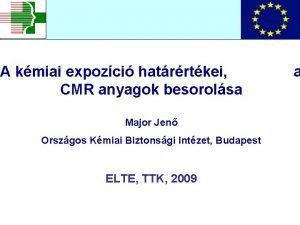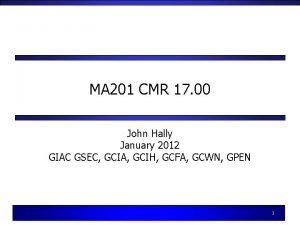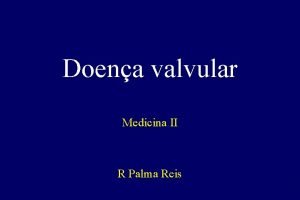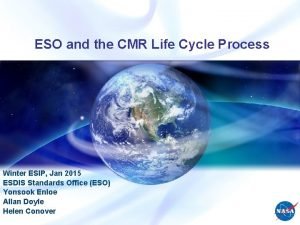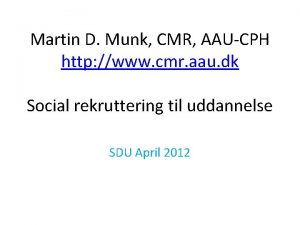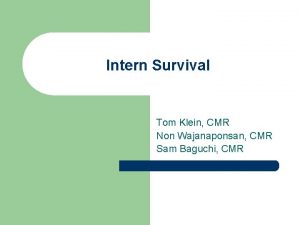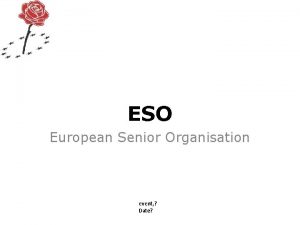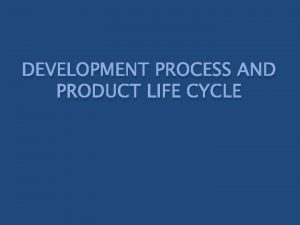ESO and the CMR Life Cycle Process Winter








- Slides: 8

ESO and the CMR Life Cycle Process Winter ESIP, Jan 2015 ESDIS Standards Office (ESO) Yonsook Enloe Allan Doyle Helen Conover

ESDIS Standards Office (ESO) Background • • • The ESDIS Standards Office (ESO) assists the ESDIS Project in formulating standards policy for NASA Earth Science Data Systems (ESDS), coordinates standards activities within ESDIS. Funded mission data systems can use the ESO recommended standards with high confidence that the specification is accurate and works with NASA data in NASA environments. ESO reviews an existing convention or standard to evaluate the technical value of the specification, determine its fitness for purpose, confirm that working implementations exist. ESO supports developing standards via feedback to the authors of new specifications in order to help improve the quality of the developing standard. ESO also can help evaluate developing standards by evaluating a prototype of its capabilities. The ESO supports the CMR Systems Engineering Team (SET) by managing and conducting a series of internal and public reviews of the developing specifications for the Common Metadata Repository (CMR), including the underlying Unified Metadata Model (UMM) 2

Stakeholder Input on CMR To maintain the quality and usefulness of EOSDIS metadata for users (discoverability, usability, etc. ), CMR relies on stakeholder input into all aspects of CMR including UMM concepts, GCMD Keywords, and documents that describe CMR processes. The ESO review process for the CMR developing standards and best practices will be a regular part of the CMR development. • • ESO reviews will be a routine and regular part of the CMR life cycle for metadata moving forward. These reviews need stakeholder participation. Reviews will be conducted via Jama, an easy-to-use, online tool. We have Jama guides and a 4 minute training video for ESO reviewers to make it as easy as possible. ESO and SET are building and maintaining lists of stakeholder subject matter experts who can be called upon for reviews. Please contact ESO or Yonsook Enloe (eso-staff@lists. nasa. gov, Yonsook. K. Enloe@nasa. gov) to have your name added to the list of reviewers. 3

How to Request a Change to CMR All requests for changes or additions to CMR use the existing support email already used for reporting issues and bugs across ESDIS supported systems: support@earthdata. nasa. gov This includes change requests for: • All CMR system components: CMR/ECHO APIs, CMR/ECHO tools and their interfaces, GCMD-related tools such as doc. Builder, GCMD Portals and their configurations, Keyword Management System, and any other related tool or service • All CMR metadata components: UMM-*, GCMD DIFs/SERFs, GCMD Keywords, other controlled vocabularies, schema constraints, ingest/output formats/standards, etc. This also includes routine requests for new keywords to support new platforms, instruments, organizations, science disciplines, etc. 4

CMR Life Cycle Overview The CMR life cycle defines the process by which requirements for all CMR elements are managed, updated, modified, reviewed, and approved for implementation through open and transparent processes involving all stakeholders. 1. Change request received from stakeholder 2. After initial vetting, CMR Systems Engineering Team (SET) assembles a team to do cost-benefit analysis of change and presents recommendation to SET Lead. 3. If approved, requirements undergo internal review (in Jama) 4. Changes that impact external stakeholders (e. g. DAACs, users) undergo ESO review • Analysis team prepares formal package for ESO. • ESO assembles Technical Working Group (including DAAC representatives) to conduct review, collect comments, and make a recommendation on the proposed change. • Some reviews will be internal and/or for comment only • Analysis team dispositions any comments 5. Final requirements package goes to CMR Project Manager for approval. 6. If approved, changed requirements get scheduled for implementation 7. New release is publicly announced. 5

Major CMR Current Activities Defining and documenting processes: CMR Life Cycle Document – Describes process for assessing, reviewing, and approving requirements for CMR including UMM concepts, GCMD Keywords, and other controlled vocabularies CMR Metadata Quality Assurance Life Cycle Document - Describes the process for reviewing all CMR metadata content to maximize data discoverability and usability; includes periodic reviews of all metadata and methods for assessing quality GCMD Keywords Community Guide – Targeted for the community, contains information on GCMD keywords, keyword structure and rules, and an overview of how GCMD engages with the community to keep the keywords relevant and useful Implementing these processes for: UMM-C (Collections) - Metadata model for collections that harmonizes the GCMD DIF and ECHO 10 models, including mappings to ISO 19115 UMM-G (Granules) - Metadata model for granules, largely based on ECHO 10 UMM-S (Services) – Metadata model for services, initially based on GCMD SERFs UMM-P (Parameters/Variables) – Metadata model for parameters/variables (e. g. , AESIR) UMM-V (Visualization) – Metadata model to support visualization tools, initially GIBS 6

Next Steps ESO Reviews of CMR UMM-C, UMM-G Dec 2014 UMM-S, UMM-V Feb/March 2015 ESO will seek reviewers drawing upon the lists of participants being provided by the DAACs and also add subject matter experts 7

Related Resources ESO Main Page • https: //earthdata. nasa. gov/eso ESO Standards and References • https: //earthdata. nasa. gov/data/standards-andreferences ESO Standards Process • https: //earthdata. nasa. gov/data/standards-andreferences/standards-process-overview ESO CMR Review Page • https: //earthdata. nasa. gov/eso/cmr-reviews 8




